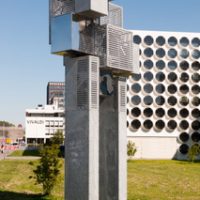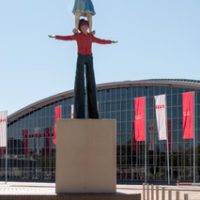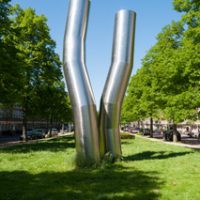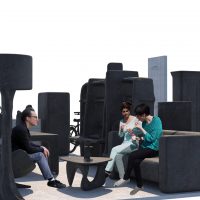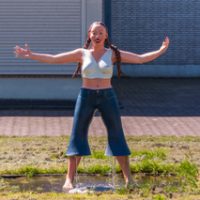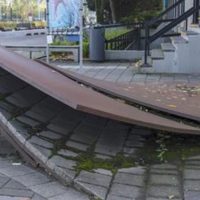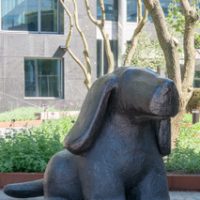Primum movens ultimum moriens, Lucien den Arend, 1986
Professor Durrerplantsoen
This is a monument for the cardiologist Prof. Dr. Durrer from Amsterdam. He is regarded as the founder of cardiology in the Netherlands. Two years after his death the park was renamed Durrerplantsoen and an artwork by Lucien den Arend was commissioned in commemoration.
Primum movens ultimum moriens: that which moves first, dies last. It is the title of Dirk Durrer’s inaugural lecture, delivered at his appointment as professor of cardiology (the first in Amsterdam) in 1957. These days, the text is carved in stone on Durrerplantsoen, a part of Minervaplein dedicated to the cardiologist. Durrer is regarded as the founder of cardiology in the Netherlands. Two years after his death the small park was renamed after him and a monument by Lucien den Arend was erected in commemoration. The monument was officially unveiled by Princess Juliana in 1986.
The monument bears the same title as Durrer’s inaugural lecture and represents the aortic arch. Two parallel silver tubes are bent into a graceful curve, vertically as well as horizontally. Walking around it, the work unfolds into a dynamic interplay of lines. The work may appear abstract at first sight, but being based on the representation of a blood vessel it is actually realist.
Primium movensis an exception on this route, as it is a monument rather than an artwork. But there are all sorts of monuments. The erection of a monument always indicates something about the zeitgeist. Apart from an object of remembrance, monuments also promote prevalent issues from a specific period. As such, its form says a lot about the way the community to which it belongs sees itself. What values do they uphold? Primum movensis a monument honouring a man who was a doctor and a scientist, not a political power or a king. This fact may well reflect the values that constitute the community’s identity.
Because the audience of art in public space is hard to identify, many public artworks tend to address the masses rather than the individual. Yet Primum movensrewards the persistent (individual) spectator. It is a homage to Durrer but at the same time it functions as an autonomous artwork. It is an effective public work of art, as it opens up on multiple levels and addresses a broad audience.
More information
Primum movens ultimum moriens op de officiële website van Lucien den Arend: http://www.denarend.com/cities/amsterdam/durrer/04.htm

